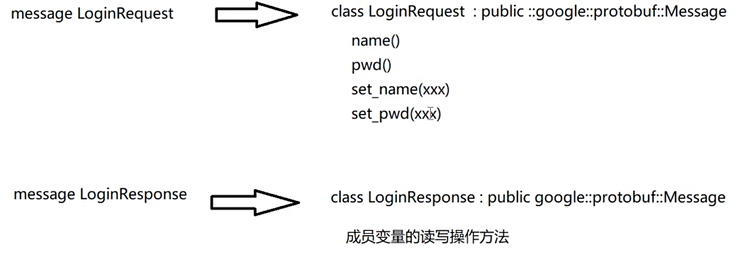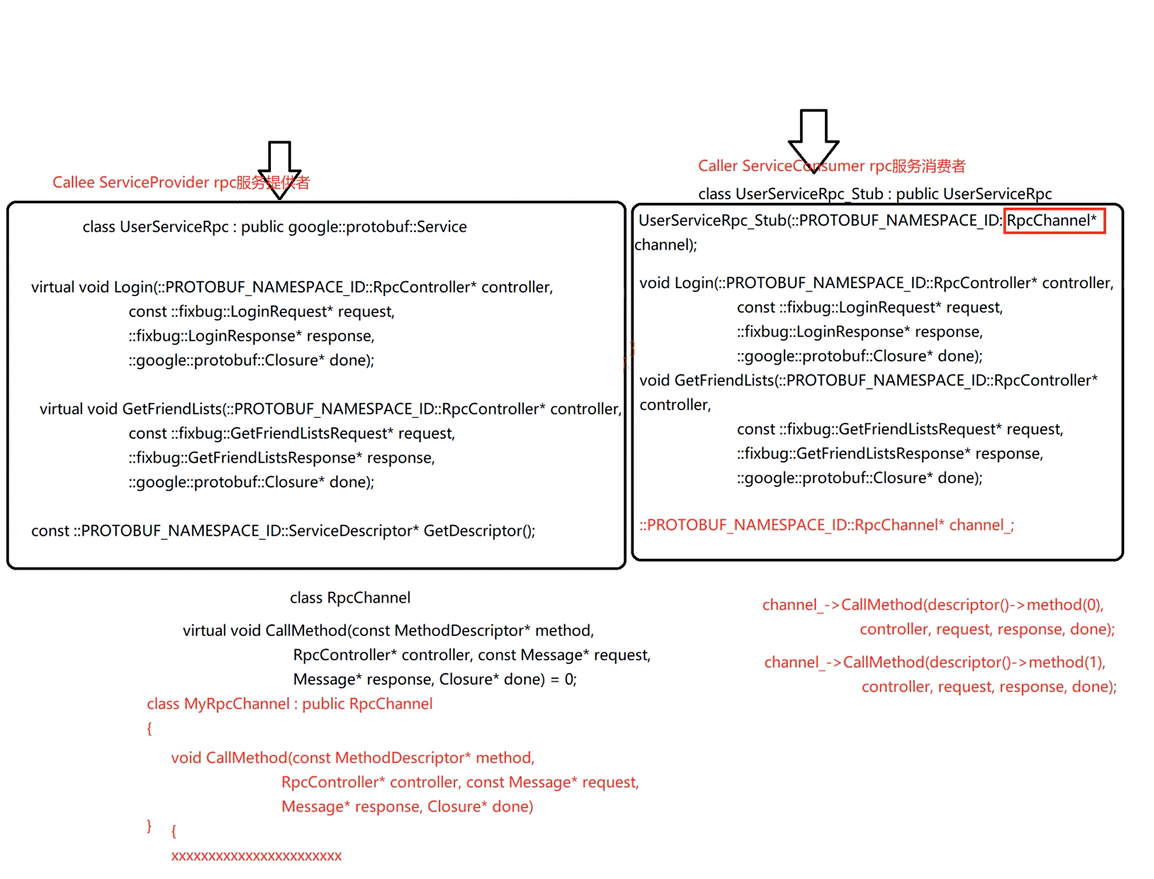04_protobuf
protobuf(protocol buffer)是Google的一种数据交换的格式,独立于平台语言。
protobuf提供了多种语言的实现:Java、C#、C++、Go和Python等,每一种实现都包含了相应语言的编译器及库文件。
安装
见《mprpc_环境配置》一篇。
安装成功后,可以在命令行输入protoc,这是protobuf的编译命令,可通过简单的配置文件生成相应的代码。
比如命令行的可选项:
1 | --cpp_out=OUT_DIR Generate C++ header and source. |
VSCode插件
可以安装一个vscode-proto3
定义消息类型 - message
本质上,message是生成了一个公有继承于::google::protobuf::Message的类。
提供了message成员变量的读写方法、(反)序列化方法。

示例
在项目目录下创建一个test文件夹,在其中再建一个protobuf文件夹。
进入文件夹,新建一个test.proto、main.cc进行测试。
1 | syntax = "proto3"; //声明protobuf的版本 |
其中的string不代表具体的某一语言当中的字符串类型,而是protobuf中的字符串类型。也就是说,protobuf中的类型只是个抽象,具体实现则看你是用哪种语言编译。
属性后面的 = 1数字1不代表字符串的值,而是声明此属性为第几个字段。
protobuf给属性生成的方法
set_xxx(param)xxx()
protobuf生成的类都会给每一个属性提供set_xxx(param)和xxx()的方法,分别是写入、读取。
序列化方法
protobuf生成的类有一系列的序列化方法。返回值为bool,true表示序列化成功。调用时需要用一个protobuf类对象调用。
如:
- SerializeToString - 序列化到字符串中
1
bool SerializeToString(std::string* output) const;
- SerializeToArray - 序列化到字节数组中
1
bool SerializeToArray(void * data, int size) const;
- SerializeToFileDescriptor - 序列化到文件描述符
- SerializeToOstream - 序列化到输出流
反序列化方法
protobuf生成的类,相应地有一系列的反序列化方法。返回值为bool,true表示反序列化成功。调用时需要用一个protobuf类对象调用。
如:
- ParseFromString
1
2
3
4inline bool ParseFromString(const std::string& data)
{
return ParseFromArray(data.data(), static_cast<int>(data.size()));
}
protobuf的“编译”–protoc生成相应语言的代码
1 | protoc test.proto --cpp_out=./ |
其中,--cpp_out选项是指明生成Cpp头文件和源文件,后面带的参数指明生成的目录。格式:--cpp_out=OUT_DIR。
相应地,也会有其他语言的选项,如--java_out就是生成Java源文件(Java没有头文件);python_out就是生成python源文件。
执行该命令,当前目录下出现:test.pb.cc和test.pb.h。
其中,test.pb.h包含LoginRequest和LoginResponse类的定义,而且它们已经自动包含到了xcg的namespace。
编写cpp文件, 使用protobuf的生成类
1 | // main.cc |
编译命令:注意需要链接protobuf的库。
1 | g++ main.cc test.pb.cc -lprotobuf |
运行结果:
1 |
|
string和bytes
在编写protobuf文件中的类型时,尽量不要用string类型,而是用bytes类型,可以避免中间传输、存储字符数据时,额外的字符、字节之间的转换。因为bytes存储意味着直接以原始二进制进行存储。如果使用string,中间过程存在着字符到字节码的相互转换。
比如如果存在Unicode,则使用string可能会存在存储效率不高的问题。
1 | //定义登录请求消息类型 |
三种类型
- 数据
- 列表(数组)
- 映射表(map)
嵌套类中的属性方法
如果是嵌套类,比如我们定义的ResultCode,那么这个子类的每一个属性的方法是mutable_xxx(),这个返回的指针是非const的。普通的xxx()方法返回的是const值,不可修改。
1 |
|
列表 - repeated
1 | message GetFriendListsRequest |
写到此,我们发现,不同的响应类可能用到重复的属性,即errcode和errmsg,可以抽象封装为一个ResultCode类型。
1 | message ResultCode |
于是,响应类可以改为:
1 | message LoginResponse |
User
其中枚举的0和1不代表字段的顺序,而是和普通语言一样的定义方法,从0开始。
1 | message User |
GetFriendListsResponse - 使用列表存储
列表需要使用repeated关键字代表。
1 | message GetFriendListResponse |
列表类的属性方法
xxx_size() - 返回列表大小
add_xxx() - 添加、返回一个可写元素
可以看到,对于repeated类型,即列表类型,都生成了add_xxx()方法。往列表里增加一个空元素,并返回该元素的地址。我们可以对其进行修改。
1 | ::xcg::User* add_friend_list(); |
xxx(int) - 返回某下标处的只读元素
列表类型,有一个xxx(int)方法。可以返回只读数据。(返回一个const引用)
1 | const ::xcg::User& friend_list(int index) const; |
用此方法结合friend_list_size方法,可以遍历列表中的元素。
修改protobuf自定义类型成员的方式
前面自定义了ResultCode,但是在编写cpp代码时,发现其没有生成set_result方法,只有result方法,此方法返回的是对应类型的常引用。这说明自定义的类对象统一都视为const类型。幸亏的是,还提供了一个方法是mutable_result方法,返回的是普通指针,可用此指针写入数据。
1 | const ::xcg::ResultCode& result() const; |
所以,修改自定义类型成员的正确方式:
1 | int main() |
映射表 - map
1 | message LoginRequest |
定义描述rpc方法的类型 - service
service本质上是继承了::google::protobuf::Service类,生成了service包含的rpc方法。还提供了一个返回服务描述符的方法。

生成的这个UserServiceRpc类不用填参数,有默认构造。此类属于服务提供者(callee)。其中的方法都是虚函数。
还对应生成了带_Stub后缀的类。继承于上面这个不带后缀的类。需要填写一个RpcChannel*指针作为成员变量进行构造。没有默认构造。此类属于服务调用者(caller)。由于继承的是上面这个类,其中的方法也是虚函数。
这个_Stub类中的方法实现都是通过调用channel的CallMethod方法进行的,第一个参数都是descriptor()->method(n),n为rpc方法的顺序号。
这个RpcChannel类是个抽象类,其中的CallMethod是纯虚方法。
需要我们去实现一个MyRpcChannel,并实现具体的CallMethod。
前言
在分布式框架中,最主要解决的问题就是远程过程调用。
直白一点,server1想要调用另一个主机上server2的方法。
不仅仅需要传请求参数,server1还需要说明自己想要调用哪个方法。总之,需要传方法名字标识、请求参数。
protobuf的核心功能定位在于对参数的序列化、反序列化。
第二个核心功能就是,帮我们区分调用哪个方法。但是要明白的是,protobuf本身不提供任何的RPC通信功能,它只是对方法进行描述。
rpc关键字:示例
1 | rpc 方法名(message类型) returns(message类型); |
1 | service UserServiceRpc |
option关键字:示例
如果只是写了上面的代码,用protoc编译,默认是不会生成我们声明的所有service服务类和rpc方法描述的。
要生成,需要在proto文件中显式声明option语句。
1 | option cc_generic_services = true; |
上面这句表示:生成所有定义的service服务类和rpc方法描述。
服务类和rpc方法描述类
经过编译链接后,新生成的pb.h文件中:
生成了UserServiceRpc类、UserServiceRpc_Stub类。
服务类,此例为UserServiceRpc,继承于::google::protobuf::Service。
并且其中生成了protobuf文件中定义的自定义方法:
virtual void Login(...)virtual void GetFriendList(...)
还有获取rpc方法描述的GetDescriptor方法:
1 | const ::PROTOBUF_NAMESPACE_ID::ServiceDescriptor* GetDescriptor(); |
该描述包括:服务的名字、服务包含的方法(包括该方法是属于哪个类的)。
实际上,类似于UserServiceRpc这个类,在分布式框架中是callee的角色,充当RPC Service Provider,即服务提供者。
Stub类 - 继承于Service类
1 | class UserServiceRpc_Stub : public UserServiceRpc |
实际上,Stub在分布式框架中是caller,充当Service Consumer,即服务消费者。
-
带参构造函数
1
UserServiceRpc_Stub(::PROTOBUF_NAMESPACE_ID::RpcChannel * channel);
-
成员变量:
::PROTOBUF_NAMESPACE_ID::RpcChannel * channel_
其次,该类也生成了protobuf文件中定义的自定义方法:
void Login(...)void GetFriendList(...)
注意,虽然没写明virtual,但因为继承于UserServiceRpc,所以同样是虚函数,只不过生成Stub类时自动实现了该函数。
1 | void UserServiceRpc::Login(::PROTOBUF_NAMESPACE_ID::RpcController* controller, |
RpcChannel
1 | class PROTOBUF_EXPORT RpcChannel |
在上面的Stub类中的“生成函数”中可以看到,最终调的是其构造时传入的channel对象的CallMethod方法。而RpcChannel中的CallMethod是个纯虚函数:
1 | virtual void CallMethod(const MethodDescriptor* method, |
说明,需要自定义一个MyRpcChannel,继承于RpcChannel,并实现具体的CallMethod。在构造Stub类对象时,传入此MyRpcChannel。
总结
整个RPC框架的流程:(以完成Login举例)
- User调用
UserServiceRpc_Stub类中的Login。 UserServiceRpc_Stub类就充当中间调用者,最终调用其RpcChannel成员的具体实现的CallMethod方法。- 不同的Stub的成员函数,对应着一个特定的method ID,比如Login,对应
descriptor()->method(0),GetFriendList,对应descriptor()->method(1)。 - 具体的method,需要Rpc Service Provider来提供,即
UserServiceRpc类。同时,Rpc方法的具体描述也会在此类中存储。描述包括:服务的名字、服务包含的方法(包括该方法是属于哪个类的)。 - 最终,在远端的Server上执行该method方法。
- User的调用请求在远端Server处理完成后,结果就从Server进行回传。
本地服务发布为rpc服务
远端,服务的提供方,本地服务类,如何对接到rpc框架?
1 |
|
本地服务类,继承于UserServiceRpc,需要实现其中的Login(...)方法,即protobuf中定义的rpc方法描述。
- 以此作为rpc远端调用的接口;
- 在此接口里,进行远端参数的获取;
- 然后对这些参数进行本地处理;
- 处理后,进行响应体的填充;
- 调用
done->Run()。进行回调。主要完成响应体的序列化以及发送响应(由rpc框架完成)。
Closure
done是Closure类型,此类为抽象类,内容很简单,有一个Run纯虚函数:
1 | class PROTOBUF_EXPORT Closure |
说明,需要先自定义一个MyClosure,具体实现Run方法逻辑,再在外部调用Login时传入此Closure指针。